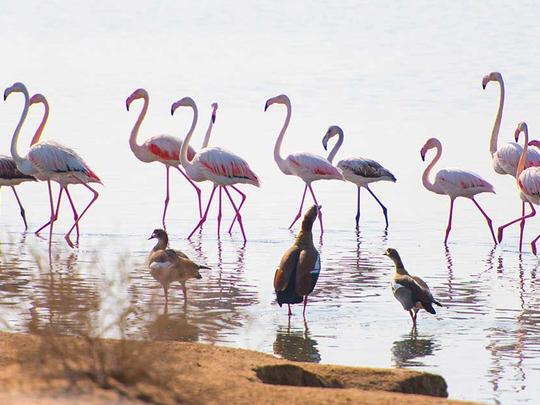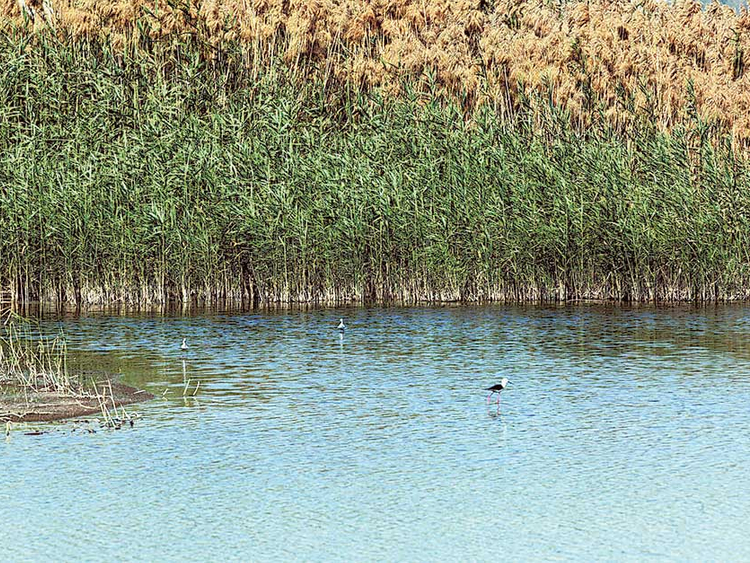
The UAE has a reputation for outstanding growth and glittering skylines. Most of the time people forget about the abundant natural beauty that this diverse country is home to. Each of the seven United Arab Emirates has its own unique natural areas that are, for the most part, untouched and unaltered by man. Here are the top 11 natural hidden gems of the UAE that encourage you to go beyond the man made glitz and glamour.
Abu Dhabi
1. The Wathba Wetland Reserve
Located on the edge of Baniyas, this natural reserve is situated in an off the beat, blink and you’ll miss it, location. The wetland reserve is also known as Flamingo City and is totally worth finding if you want to experience a whole other side of the UAE. It is one of the few undisturbed wildlife areas in the country and is also very remarkable and known for being home to hundreds of flamingos, which you’ll be able to watch from a designated hide. The area is also beautiful for when you simply just want to take a long walk through proper woodlands and shrubbery. It will feel like a well needed escape from the usual bustling city life. Contact 02 445 4777
2. Jebel Dhanna
In an area just north of Abu Dhabi, around the coastal regions, there are several mountains and beautifully scenic sea cliffs that are home to some amazing rock formations. Through these particular sites ran an ancient river, which dried out and left certain stone formations that are made up of unusual vertebrate fossils. These formations are known as the Baynunah and Shuwaihat. Some really cool fossils have been found in the rocks, such as the jaw of a hippopotamus, the skull of an 8 million year old crocodile, and the molar tooth of an elephant. In a country that is technically just over 40 years old, it’s enthralling to be walking around on ancient rocks that have been around longer than the UAE itself.
Dubai
3. Big Red
Located just outside of Dubai on Hatta Road (E44), is a magnificent open dessert that beautifully juxtaposes the city life. You'll notice that the further you drive away from the city, the deeper the red colour of the dessert becomes. Then you’ll hit Big Red, a pretty popular spot for bashing dunes, but a beautiful and picturesque desert away from the hustle of Dubai. Grab some food, lots of water and enjoy a fiery red day out in the desert.
4. Fossil Rock
Fossil Rock is an unforgettable and surreal experience. Many of the fossils there are said to be over 80 million years old. To get there you need to drive down the Dubai- Hatta road through to Al Awir. Once you arrive at Fossil Rock, take a moment to sit among fossils that are over millions of years old, enjoy clear blue skies, rocky hills and pristine dessert sand in one of the UAE's natural wonders.
Ras Al Khaima
5. Wadi al Bih
Affectionately known as the Grand Canyon of the UAE, Wadi Bih is a deep ravine with a distance of 1 kilometre. The top of the wadi gives you some of the best views of the UAE. The whole thing spans from the Ras Al Khaimah clock tower all the way near the UAE boarder check point. Visitors of Wadi al Bih can go hiking, mountain biking and camping in the area. Wadi al Bih also has some very interesting sights nearby such as the infamous deserted villages of RAK, other smaller wadi areas and some unexpected amount of natural greenery as well as gorgeous views of a great outdoors that we don’t get to experience much while living in the city.
6. Wadi Ghalilah
This beautiful wadi is a favourite spot for many rock climbers. Located two hours out of Dubai, Wadi Ghalilah is quite close to Ras al Khaima’s coastline. It is known to be smaller and less extensive than Wadi Bih, but has many steeper rocks and cliffs. The wadi also has quite a low altitude and because it is so close to water, the humidity and heat make it quite difficult to trek. Stairway to heaven is the name of one of the wadi’s more dangerous mountains. It stands at a high 1.9 kilometres and is not recommended to climb without someone who is really familiar with the mountain. Additionally, many experienced climbers have alleged that the climb is quite physically and emotionally unnerving.
Fujairah
7. Mountain Safari
Just by driving towards Fujairah, you begin to rise in altitude and see a lot more rocks and cliffs lining the roads. Because the emirate is mostly made up of mountainous, Fujairah provides great opportunities to have a mountain safari. The terrain ranges from steep and high mountains to plummeting wadis, which means it’s the perfect place to get your four wheel drive going. Fujairah in general is often visited for its beautiful Indian Ocean and active marine life, but the mountains and wadis are natural hidden gems packed with excitement and adventure.
Sharjah
8. Wasit Nature Reserves
A 4.5 square kilometre area that has previously been used for dumping trash, has now been converted into a beautiful nature reserve, with birds flocking from around the world. The Wasit Nature Reserve located on the Sharjah-Ajman border, was declared a protected area in 2007 by His Highness Dr Shaikh Sultan Bin Mohammad Al Qasimi, Supreme Council Member and Ruler of Sharjah. It’s a flourishing area that allows visitors to have a closer look at rare birds and other wetland species. The nature reserve houses four natural lagoons attracting around 150 species of birds, both migratory and resident, throughout the year. The water bodies are supported by underground water channels flowing out of Hatta Mountain and Al Falaj areas.
Umm al Quwain
9. Umm al Quwain wetlands
The emirate of Umm al-Quwain is one of the best indicators of how the UAE used to look like. It has been built nearby a prominent and bright blue lagoon, surrounded by little islands. These islands are perfect locations for bird watchers and all around nature enthusiasts. The wetlands are perfect to explore by boat or by kayak especially the mangroves and the water channels between the islands.
10. Khor al Beidah
Khor al Beidah is a super popular spot for wildlife and for bird watching. Located on the Al Sinniyah Island, the largest of the Um al Quwain islands, which is a marine life preserve as big as 90 square kilometres. If bird watching is your thing, the best time to visit would be in between November and March, which means that great bird species will be coming in. the Island’s shallow lagoons and mud areas make the perfect habitat for feeding and nesting for many birds.
Ajman
11. Masfout
Ajman, the smallest emirate in the UAE is a surprisingly refreshing escape from the city bustle and heat. Masfout is one of the city’s 2 hours outside of Ajman is a favourite local escape and a beautiful summer retreat. Because the area is at a higher altitude and at a nice two hour distance from the city center, there’s cooler climates a pollution free fresh breeze. Ajman’s unexpected rocky countryside is a perfect spot for walking, mountain biking, picnics and wadi exploration. The robust setting has some beautiful flora and fauna and before the city was built used to be home to leopards, gazelles and foxes. The area has no tourism yet, as there are no hotels in Masfout yet, so now may be the best chance to check these places out.









